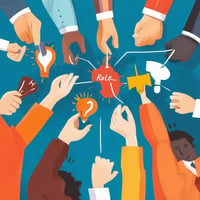Do you want to know how to become a human resource manager? If you enjoy working with people,...
Human Capital or HR: Which Wins in 2025
Why Should You Care About Human Capital vs Human Resource?
If you’ve ever wondered what really makes your workforce shine, you’re not alone. The terms human capital and human resource get thrown around a lot, but they’re not quite the same thing. Understanding the difference can actually make a big impact on how your organization grows and thrives.
Simply put, human capital is about the value people bring through their skills, knowledge, and creativity. On the other hand, human resource management is about putting the right systems and policies in place to manage those people effectively. Let’s dive into these ideas and see how each plays a vital role in your company’s success.
What Exactly is Human Capital?
It’s More Than Just Skills
Think of human capital as everything your employees carry with them—their talents, what they know, and their life experiences. It’s the unique mix that makes them great at what they do. Investing in human capital means nurturing those talents through ongoing learning and growth.
But it’s not just about technical know-how. It’s creativity, problem-solving, emotional smarts—those things that make your team adaptable and ready for whatever comes next. Especially today, when things change fast, having a workforce that learns and grows is a game changer.
Why Does Human Capital Matter So Much Today?
In our modern world, smart and skilled employees are the real drivers behind a company’s success. When you invest in your people, you get:
-
Fresh ideas and innovation that keep your business ahead
-
Employees who stick around longer because they see a future with you
-
Better service and happier customers thanks to skilled and motivated staff
Simply put, your people are your biggest asset.
So, What is Human Resource Then?
The Backbone of People Management
If human capital is what people bring, human resource (or HR) is about how you organize and support those people. HR takes care of the nuts and bolts—hiring, training, performance reviews, and making sure everything runs smoothly and by the book.
But HR isn’t just paperwork and policies anymore. Today’s HR professionals are key to building a workplace culture where people feel connected and valued.
What Does HR Actually Do?
-
Finding the right people to join your team
-
Helping everyone get up to speed and keep learning
-
Checking in on how folks are doing and helping them get better
-
Resolving conflicts and making sure the office vibe stays positive
Good HR helps everyone stay focused and aligned with company goals.
Human Capital vs Human Resource: What’s the Real Difference?
| Focus | Human Capital | Human Resource |
|---|---|---|
| What it’s about | People’s skills and potential | Systems and policies for managing |
| How it works | Growing employee value over time | Running smooth operations |
| Why it matters | Drives innovation and growth | Keeps things fair and organized |
They’re both important, but with different jobs. Human capital is about unlocking potential; HR is about managing that potential well.
Why Putting Human Capital First Pays Off
Engaged Employees Do More
When people feel their growth is backed by the company, they show up energized and ready to contribute. They see a path forward and work better together. This means:
-
Clear opportunities to grow and advance
-
Teams that collaborate and support each other
-
A boost in overall productivity and happiness
It’s a Win for Your Whole Company
Investing in human capital means your business can:
-
Solve problems more creatively and quickly
-
Keep pace with industry changes
-
Stay competitive with a workforce that’s always learning
But Don’t Forget: HR is Your Operations Hero
Keeping Things Organized
HR keeps processes consistent so everyone knows what to expect. This means less wasted time and more focus on what really matters.
Protecting the Company (and Employees)
HR handles tricky stuff like legal rules and workplace safety, making sure everyone stays protected and the company avoids costly risks.
Bringing Human Capital and HR Together
Best Way to Build a Winning Team
The magic happens when you blend the strengths of human capital and HR. For example:
-
Make sure training programs help people AND support business goals
-
Use regular feedback to keep everyone growing
-
Get HR and leadership working hand in hand to balance people’s needs with company priorities
This teamwork helps companies build a skilled, motivated workforce AND keep operations running smoothly.
Real Stories That Show it Works
-
A global tech company boosted employee engagement by 30% and productivity by 20% with leadership training and smarter feedback processes.
-
A financial firm cut employee turnover from 25% to 10% through a mix of mentoring and strong HR tracking.
Seeing is believing—these strategies really move the needle.
Wrapping Up: Both Matter for the Future
The takeaway? Don’t think of human capital and human resource as rivals—they’re teammates. Investing in your people’s skills and handling them thoughtfully with solid HR processes together create a thriving workplace that’s ready for whatever the future holds.
If you want to explore smart HR and workforce solutions, check out recruire.com and start unlocking your company’s full potential today!
FAQs
What’s the main difference between human capital and human resource?
Human capital is about people’s talents and growth, while HR focuses on managing those people effectively.
Why invest in human capital?
Because it fuels innovation, keeps employees engaged, and strengthens your business over time.
How do you bring human capital and HR together?
By aligning employee development with business goals, providing feedback often, and fostering close teamwork between HR and leadership.



